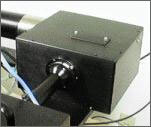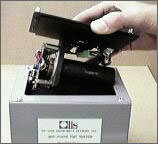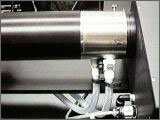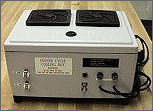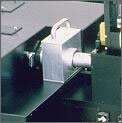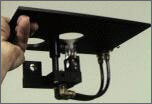Components of the RSM
Main Components
The basic RSM 1000 includes the patented DeSa monochromator, two 50-mm gratings blazed for the wavelength range of your choice; a ScanDisk, a sample chamber, two PMTs, a lamp suited to your intended application, a computer with twin 2-Mhz 14-bit A/D systems, and Olis GlobalWorks Software.
The DeSa Monochromator
The patented double-grating monochromator by Richard J. DeSa has stationary optics during scanning. In its unique rapid-scanning mode, only the intermediate slit moves. Conventional scanning by moving the gratings is possible, too.
All early models have an aperture of 4.5 and a focal length of 250 mm. As a subtractive double monochromator, the DeSa model features exceedingly low stray light, high light throughput, a homogeneous output beam, and bandwidth determined by the moving intermediate slit. The DeSa monochromator has all reflective optics, making it usable throughout the UV/Vis/NIR range. One RSM can have almost arbitrary wavelength range(s), wavelength span(s), and spectral resolution(s), as determined by the gratings and ScanDisk. How is spectral bandpass calculated in the RSM?
This diagram and photo show the optical path of the DeSa monochromator. The mirror-image optics make it possible to reverse the optical path as the experimental situation requires, making the monochromator equally useful for excitation/ low-light use.
Gratings
Gratings determine the optimized spectral range and spectral resolution of the DeSa monochromator. Gratings are accessed and exchanged easily, such that one monochromator can be used for high resolution ultraviolet (UV) and moments later for broad band work in the NIR. Click on the chart to view chart full size.
ScanDisk
The patented ScanDisk houses the moving intermediate slit. Multiple ScanDisk configurations are available to support optimization of scan rate, wavelength span(s), and spectral bandwidth(s). Thus, exchanging ScanDisks™, allows one RSM to have potentially widely varying wavelength span(s), scan speed(s), resolution(s), and sample illumination time(s). Most labs have several ScanDisks™, each optimizing the RSM for different experiments.
Click here to view a dynamic simulation of the scan disk at work!
Computer Hardware
There is no point in using the RSM without the computer control; it's just "Richard's Spinning Machine" without data collection and analysis capabilities! Windows XP-based, including a 2.66 GHz Intel Core®2 Duo processor, high resolution 17 LCD and Olis GlobalWorks Software.
Support Hardware
RSM Photometer Box
Two channels with high-speed, low-noise amplifiers and two programmable high-voltage power supplies. Some applications suggest single channel with high-speed, low-noise amplifier and single programmable high-voltage power supply.
Beam Splitter & Reference Channel
A beam splitter to produce two light beams for true sample and reference collection is standard in all RSM systems; this beam splitter can be removed when maximum light throughput is more critical than dual-beam (sample-reference) detection. A mirror-type optical beam splitter, useful where a reference PMT can be positioned near the entrance port of the stopped-flow, is also available. Both 50/50 and 80/20 splitters are available.
Sample / Reference PMTs
Photomultiplier tubes are used for highest sensitivity and speed over the ~180-800 nm range. Red-sensitive PMTs are available to extend into the NIR to approximately 1200 nm, albeit with higher noise. For low noise performance from 800 to upwards of 2600 nm, InGaAs detectors are available. For low light level situations where ultimate speed is not required, photon counting detectors are used. All detectors are end-on, other than the “mid-plane PMT,” which is used to capture rapid-scanning emission from DeSa monochromator used in its single grating mode.
Detectors are easily accessed and exchangeable for optimization for response time, gain settings, and spectral ranges. The photomultiplier tubes support submicrosecond detection rates and fully computerized gain settings. The photon counters are gated.
Lamp, Housing, & Power Supply
Most RSM systems are fitted with 75-watt xenon arc lamps in an elliptical reflective housing. Other light sources are 150-watt deuterium and xenon, pulse lamps, lasers, etc. Given the high scan speed of the RSM, the brightest cost-justifiable illumination is recommended. The usual lamp power supply is a 150-watt model fitted with the lamp starter, useful for starting 75- or 150-watt
Optional Components
"Sister" Monochromator
For work requiring a second monochromator, such as fluorescence studies where the RSM will be used as the emission monochromator, the Olis "sister" monochromator is available. This compact single monochromator features a servo-motor-driven 40 x 45 mm concave holographic grating, conventional entrance and exit slits, and a place for a second-order filter. The Olis "sister" monochromator provides high light throughput and the equivalent wavelength range of scores of optical filters (~ 220-800 nm; varies with light source). It can be adjusted using a simple keystroke command to the software.
Middle-Plane PMT
The Olis middle-plane PMT is the easiest, most economical way to enhance the RSM's fluorescence performance. Positioned directly behind the ScanDisk (equivalent to the intermediate slit in conventional monochromators), this high-gain, side-window PMT provides approximately a 10-fold increase in photosensitivity by eliminating two mirrors and a grating from the path of the emission beam. The pin connection to the amplifier box is external because the PMT is mounted and wired to the underside of a removable lid. A protective metal container is provided for safe storage of the PMT when it is not in use.
Beam-Cooling Accessory
Positioned between the lamp housing and the monochromator, the nickel-plated brass Olis beam-cooling accessory removes the IR from the output beam, providing protection for photolabile samples and the monochromator's optics. Required for 450- and 1000-watt lamps and therefore included as part of the standard "Full Fluorescence Optimization" packages; optional for 150 watt lamps and priced separately.
Closed-Cycle Cooling System
The Olis closed-cycle cooling system requires no external water source in order to maintain a constant safe temperature for the fluid it circulates to the 450 watt Xenon arc lamp and associated beam-cooling accessory. The lamp power supply is plugged into the closed cycle cooling system rather than into the wall, so that the lamp cannot be turned on unless the cooling system is running and will be shut off if the cooling system is compromised during use.
The cooling system is closed: the fluid is permanent. The compact "cooling box" weighs 14 pounds. and the nylon-reinforced PVC hoses are fitted with quick-connect couplers for fast and easy connection. A smaller single fan unit is provided for use with the 150 watt Xenon arc lamp and/or the Peltier cell holders.
External Shutter Box
The computer-controlled Olis external shutter box can be used both to protect photolabile samples from the excitation or the measuring beam while readings are not being made, and to turn a steady-state lamp into a pulse lamp with pulse rates to 40 Hz. The shutter box can be positioned between the sample compartment and the excitation monochromator to protect photolabile samples from the exciting beam during fluorescence work and between the DeSa monochromator and the sample compartment to protect photolabile samples from the measuring beam. The small (14-mm) aperture provides a rapid (to 40 Hz) open/ close cycle.
Hanging Cuvette Holder
Jacketed sample and reference cuvette holders are mounted to the underside of the sample compartment lid and water lines are provided for temperature control. The sample cuvette holder has windows on all four sides to allow passage of a flash beam and a measuring beam. A round opening in the lid above each cuvette holder allows easy access for inserting and removing sample cuvettes; round plastic lids slip over each of the access holes.






